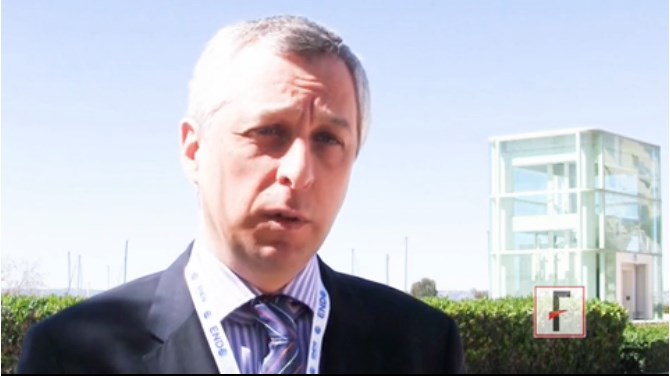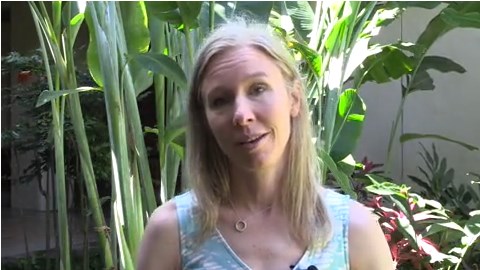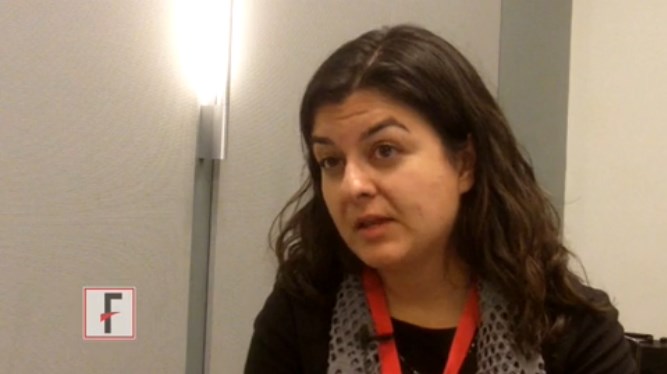User login
VIDEO: Couples more likely to conceive if men get healthy
SAN DIEGO – Conception is more likely if obese women lose weight and make other healthy lifestyle changes. What hasn’t been known until now is that the same holds true for their male partners, according to a prospective trial from the University of Sherbrooke, Quebec.
Forty-nine overweight women who were having a hard time conceiving worked with nutritionists, kinesiologists, and counselors there to improve their chances. When the investigators invited partners to join them, 25 men accepted the offer.
The men tended to be overweight and sedentary, too, compared with Canadian averages, and the program didn’t do much to change that. Even so, after about 1.5 years follow-up, couples were 33% more likely to conceive for each 1% of weight the men lost (odds ratio, 1.33; 95% confidence interval, 1.05-1.83, P = .013), with similar benefits for cutting back on soda, eating more fruits and vegetables, and other healthy diet changes.
Senior investigator Dr. Jean-Patrice Baillargeon, a professor of medicine at Sherbrooke, explained
the implications of those findings in an interview at the Endocrine Society's annual meeting.
The video associated with this article is no longer available on this site. Please view all of our videos on the MDedge YouTube channel
SAN DIEGO – Conception is more likely if obese women lose weight and make other healthy lifestyle changes. What hasn’t been known until now is that the same holds true for their male partners, according to a prospective trial from the University of Sherbrooke, Quebec.
Forty-nine overweight women who were having a hard time conceiving worked with nutritionists, kinesiologists, and counselors there to improve their chances. When the investigators invited partners to join them, 25 men accepted the offer.
The men tended to be overweight and sedentary, too, compared with Canadian averages, and the program didn’t do much to change that. Even so, after about 1.5 years follow-up, couples were 33% more likely to conceive for each 1% of weight the men lost (odds ratio, 1.33; 95% confidence interval, 1.05-1.83, P = .013), with similar benefits for cutting back on soda, eating more fruits and vegetables, and other healthy diet changes.
Senior investigator Dr. Jean-Patrice Baillargeon, a professor of medicine at Sherbrooke, explained
the implications of those findings in an interview at the Endocrine Society's annual meeting.
The video associated with this article is no longer available on this site. Please view all of our videos on the MDedge YouTube channel
SAN DIEGO – Conception is more likely if obese women lose weight and make other healthy lifestyle changes. What hasn’t been known until now is that the same holds true for their male partners, according to a prospective trial from the University of Sherbrooke, Quebec.
Forty-nine overweight women who were having a hard time conceiving worked with nutritionists, kinesiologists, and counselors there to improve their chances. When the investigators invited partners to join them, 25 men accepted the offer.
The men tended to be overweight and sedentary, too, compared with Canadian averages, and the program didn’t do much to change that. Even so, after about 1.5 years follow-up, couples were 33% more likely to conceive for each 1% of weight the men lost (odds ratio, 1.33; 95% confidence interval, 1.05-1.83, P = .013), with similar benefits for cutting back on soda, eating more fruits and vegetables, and other healthy diet changes.
Senior investigator Dr. Jean-Patrice Baillargeon, a professor of medicine at Sherbrooke, explained
the implications of those findings in an interview at the Endocrine Society's annual meeting.
The video associated with this article is no longer available on this site. Please view all of our videos on the MDedge YouTube channel
AT ENDO 2015
VIDEO: Expert tips to avoid eye ptosis
KAUAI, HAWAII– Ptosis can occur if toxins injected around the eyes are imprecisely placed, according to Dr. Brooke Sikora.
In this video report from the Hawaii Dermatology Seminar sponsored by Global Academy for Medical Education/Skin Disease Education Foundation, Dr. Sikora, a private practice dermatologist in Boston discusses how to avoid adverse events when injecting toxins around the lids and brows, and what to do should the procedure not go according to plan.
Dr. Sikora had no relevant financial conflicts to disclose.
SDEF and this news organ
On Twitter @whitneymcknight
KAUAI, HAWAII– Ptosis can occur if toxins injected around the eyes are imprecisely placed, according to Dr. Brooke Sikora.
In this video report from the Hawaii Dermatology Seminar sponsored by Global Academy for Medical Education/Skin Disease Education Foundation, Dr. Sikora, a private practice dermatologist in Boston discusses how to avoid adverse events when injecting toxins around the lids and brows, and what to do should the procedure not go according to plan.
Dr. Sikora had no relevant financial conflicts to disclose.
SDEF and this news organ
On Twitter @whitneymcknight
KAUAI, HAWAII– Ptosis can occur if toxins injected around the eyes are imprecisely placed, according to Dr. Brooke Sikora.
In this video report from the Hawaii Dermatology Seminar sponsored by Global Academy for Medical Education/Skin Disease Education Foundation, Dr. Sikora, a private practice dermatologist in Boston discusses how to avoid adverse events when injecting toxins around the lids and brows, and what to do should the procedure not go according to plan.
Dr. Sikora had no relevant financial conflicts to disclose.
SDEF and this news organ
On Twitter @whitneymcknight
AT SDEF HAWAII DERMATOLOGY SEMINAR
VIDEO: Metabolic syndrome less likely in kids who eat nuts
SAN DIEGO – Encourage teens with metabolic syndrome to snack on nuts; it just might improve their health.
Investigators from the University of Texas Southwestern Medical Center, in Dallas, found that children who ate 12.9 g of nuts per day – the equivalent of a small handful of peanuts, almonds, walnuts, and the like 3 times a week – had less than half the risk of metabolic syndrome, compared with those who did not, when age, sex, race, household income, and daily intake of sugar, fruits, and vegetables were controlled for (odds ratio, 0.43; 95% confidence interval, 0.20-0.92). The benefit persisted up to about 50 g/day, then tapered off, perhaps because the extra calories offset the metabolic benefit.
Adolescents who ate nuts a few times a week also had lower body mass index z scores, smaller waists, lower systolic blood pressure, and higher HDL cholesterol levels. Similar benefits have been found in adults.
The data come from the 2003-2010 National Health and Nutrition Examination Survey (NHANES) of 2,233 12- to 19-year-olds; nut consumption was self-reported.
Pediatrician and lead investigator Dr. Roy Kim stressed that the correlations don’t prove cause and effect. Still, he said he now encourages his patients to eat nuts. He explained why in an interview at a meeting of the Endocrine Society.
The video associated with this article is no longer available on this site. Please view all of our videos on the MDedge YouTube channel
SAN DIEGO – Encourage teens with metabolic syndrome to snack on nuts; it just might improve their health.
Investigators from the University of Texas Southwestern Medical Center, in Dallas, found that children who ate 12.9 g of nuts per day – the equivalent of a small handful of peanuts, almonds, walnuts, and the like 3 times a week – had less than half the risk of metabolic syndrome, compared with those who did not, when age, sex, race, household income, and daily intake of sugar, fruits, and vegetables were controlled for (odds ratio, 0.43; 95% confidence interval, 0.20-0.92). The benefit persisted up to about 50 g/day, then tapered off, perhaps because the extra calories offset the metabolic benefit.
Adolescents who ate nuts a few times a week also had lower body mass index z scores, smaller waists, lower systolic blood pressure, and higher HDL cholesterol levels. Similar benefits have been found in adults.
The data come from the 2003-2010 National Health and Nutrition Examination Survey (NHANES) of 2,233 12- to 19-year-olds; nut consumption was self-reported.
Pediatrician and lead investigator Dr. Roy Kim stressed that the correlations don’t prove cause and effect. Still, he said he now encourages his patients to eat nuts. He explained why in an interview at a meeting of the Endocrine Society.
The video associated with this article is no longer available on this site. Please view all of our videos on the MDedge YouTube channel
SAN DIEGO – Encourage teens with metabolic syndrome to snack on nuts; it just might improve their health.
Investigators from the University of Texas Southwestern Medical Center, in Dallas, found that children who ate 12.9 g of nuts per day – the equivalent of a small handful of peanuts, almonds, walnuts, and the like 3 times a week – had less than half the risk of metabolic syndrome, compared with those who did not, when age, sex, race, household income, and daily intake of sugar, fruits, and vegetables were controlled for (odds ratio, 0.43; 95% confidence interval, 0.20-0.92). The benefit persisted up to about 50 g/day, then tapered off, perhaps because the extra calories offset the metabolic benefit.
Adolescents who ate nuts a few times a week also had lower body mass index z scores, smaller waists, lower systolic blood pressure, and higher HDL cholesterol levels. Similar benefits have been found in adults.
The data come from the 2003-2010 National Health and Nutrition Examination Survey (NHANES) of 2,233 12- to 19-year-olds; nut consumption was self-reported.
Pediatrician and lead investigator Dr. Roy Kim stressed that the correlations don’t prove cause and effect. Still, he said he now encourages his patients to eat nuts. He explained why in an interview at a meeting of the Endocrine Society.
The video associated with this article is no longer available on this site. Please view all of our videos on the MDedge YouTube channel
AT ENDO 2015
VIDEO: Best practices for antibiotic use in acne
KAUAI, HAWAII – Should you taper or stop your acne patient’s oral antibiotic abruptly? And what are the best topical and oral antibiotics to treat chronic acne? Dr. Linda Stein Gold of the Henry Ford Hospital in Detroit addresses these concerns and discusses the latest developments in topical antibiotics at the Hawaii Dermatology Seminar sponsored by Global Academy for Medical Education/Skin Disease Education Foundation. Dr. Gold disclosed she has several industry ties, including with Galderma, Roche, and Stiefel. SDEF and this news organization are owed by the same parent company.
On Twitter @whitneymcknight
KAUAI, HAWAII – Should you taper or stop your acne patient’s oral antibiotic abruptly? And what are the best topical and oral antibiotics to treat chronic acne? Dr. Linda Stein Gold of the Henry Ford Hospital in Detroit addresses these concerns and discusses the latest developments in topical antibiotics at the Hawaii Dermatology Seminar sponsored by Global Academy for Medical Education/Skin Disease Education Foundation. Dr. Gold disclosed she has several industry ties, including with Galderma, Roche, and Stiefel. SDEF and this news organization are owed by the same parent company.
On Twitter @whitneymcknight
KAUAI, HAWAII – Should you taper or stop your acne patient’s oral antibiotic abruptly? And what are the best topical and oral antibiotics to treat chronic acne? Dr. Linda Stein Gold of the Henry Ford Hospital in Detroit addresses these concerns and discusses the latest developments in topical antibiotics at the Hawaii Dermatology Seminar sponsored by Global Academy for Medical Education/Skin Disease Education Foundation. Dr. Gold disclosed she has several industry ties, including with Galderma, Roche, and Stiefel. SDEF and this news organization are owed by the same parent company.
On Twitter @whitneymcknight
AT SDEF HAWAII DERMATOLOGY SEMINAR
Manage Your Dermatology Practice: Selecting Cosmetic Procedures to Offer in Your Practice
Dermatologists with a strictly medical or surgical practice may consider offering cosmetic procedures to their patients. Dr. Gary Goldenberg provides tips on how to market your practice as cosmetic by obtaining patient input, estimating start-up costs, and determining which procedures may benefit patients with medical conditions such as acne and rosacea.
Dermatologists with a strictly medical or surgical practice may consider offering cosmetic procedures to their patients. Dr. Gary Goldenberg provides tips on how to market your practice as cosmetic by obtaining patient input, estimating start-up costs, and determining which procedures may benefit patients with medical conditions such as acne and rosacea.
Dermatologists with a strictly medical or surgical practice may consider offering cosmetic procedures to their patients. Dr. Gary Goldenberg provides tips on how to market your practice as cosmetic by obtaining patient input, estimating start-up costs, and determining which procedures may benefit patients with medical conditions such as acne and rosacea.
VIDEO: Secukinumab ‘exciting’ new agent for psoriasis
KAUAI, HAWAII – The Food and Drug administration recently approved a new class of drug for psoriasis. Secukinumab, indicated for the treatment of mild to severe psoriasis, targets IL-17, a cytokine highly implicated in the disease.
“I’m very excited to try this drug in my patients,” Dr. Kristina Callis Duffin said at the Hawaii Dermatology Seminar sponsored by Global Academy for Medical Education/Skin Disease Education Foundation.
In this report, Dr. Duffin of the University of Utah explains the drug’s mechanism of action, describes how it differs from other biologic agents used to treat psoriasis, and shares promising data showing improved scores on the Psoriasis Area and Severity Index (PASI).
SDEF and this news organization are owned by the same parent company.
The video associated with this article is no longer available on this site. Please view all of our videos on the MDedge YouTube channel
On Twitter @whitneymcknight
KAUAI, HAWAII – The Food and Drug administration recently approved a new class of drug for psoriasis. Secukinumab, indicated for the treatment of mild to severe psoriasis, targets IL-17, a cytokine highly implicated in the disease.
“I’m very excited to try this drug in my patients,” Dr. Kristina Callis Duffin said at the Hawaii Dermatology Seminar sponsored by Global Academy for Medical Education/Skin Disease Education Foundation.
In this report, Dr. Duffin of the University of Utah explains the drug’s mechanism of action, describes how it differs from other biologic agents used to treat psoriasis, and shares promising data showing improved scores on the Psoriasis Area and Severity Index (PASI).
SDEF and this news organization are owned by the same parent company.
The video associated with this article is no longer available on this site. Please view all of our videos on the MDedge YouTube channel
On Twitter @whitneymcknight
KAUAI, HAWAII – The Food and Drug administration recently approved a new class of drug for psoriasis. Secukinumab, indicated for the treatment of mild to severe psoriasis, targets IL-17, a cytokine highly implicated in the disease.
“I’m very excited to try this drug in my patients,” Dr. Kristina Callis Duffin said at the Hawaii Dermatology Seminar sponsored by Global Academy for Medical Education/Skin Disease Education Foundation.
In this report, Dr. Duffin of the University of Utah explains the drug’s mechanism of action, describes how it differs from other biologic agents used to treat psoriasis, and shares promising data showing improved scores on the Psoriasis Area and Severity Index (PASI).
SDEF and this news organization are owned by the same parent company.
The video associated with this article is no longer available on this site. Please view all of our videos on the MDedge YouTube channel
On Twitter @whitneymcknight
AT SDEF HAWAII DERMATOLOGY SEMINAR
Memory disorders
The video associated with this article is no longer available on this site. Please view all of our videos on the MDedge YouTube channel
The video associated with this article is no longer available on this site. Please view all of our videos on the MDedge YouTube channel
The video associated with this article is no longer available on this site. Please view all of our videos on the MDedge YouTube channel
VIDEO: Challenges abound in rolling out stroke embolectomy
NASHVILLE, TENN. – U.S. stroke specialists now face the challenge of making endovascular embolectomy a routinely available option for selected patients with acute ischemic stroke, Dr. Pooja Khatri said in an interview at the International Stroke Conference.
During the conference, which was sponsored by the American Heart Association, new reports from three independent, randomized controlled trials, as well as data from a fourth study published in January, collectively established endovascular embolectomy as the new standard-of-care treatment for acute ischemic stroke patients with a proximal occlusion of a large, intracerebral artery. The stroke community, however, now faces the responsibility of figuring out how to make this a reality.
Among the hurdles they face are using CT imaging or other methods to identify in daily practice the specific patients who will get the biggest benefit from endovascular treatment and finding a consensus within each region on how to triage acute stroke patients to centers that can perform embolectomy, said Dr. Khatri, professor of neurology and director of acute stroke at the University of Cincinnati. In Cincinnati, Dr. Khatri and her colleagues are planning to soon hold a retreat with representatives from other area hospitals to try to work out the logistics.Dr. Khatri has received research support from Penumbra and Genentech.
The video associated with this article is no longer available on this site. Please view all of our videos on the MDedge YouTube channel
mzoler@frontlinemedcom.com
On Twitter @mitchelzoler
NASHVILLE, TENN. – U.S. stroke specialists now face the challenge of making endovascular embolectomy a routinely available option for selected patients with acute ischemic stroke, Dr. Pooja Khatri said in an interview at the International Stroke Conference.
During the conference, which was sponsored by the American Heart Association, new reports from three independent, randomized controlled trials, as well as data from a fourth study published in January, collectively established endovascular embolectomy as the new standard-of-care treatment for acute ischemic stroke patients with a proximal occlusion of a large, intracerebral artery. The stroke community, however, now faces the responsibility of figuring out how to make this a reality.
Among the hurdles they face are using CT imaging or other methods to identify in daily practice the specific patients who will get the biggest benefit from endovascular treatment and finding a consensus within each region on how to triage acute stroke patients to centers that can perform embolectomy, said Dr. Khatri, professor of neurology and director of acute stroke at the University of Cincinnati. In Cincinnati, Dr. Khatri and her colleagues are planning to soon hold a retreat with representatives from other area hospitals to try to work out the logistics.Dr. Khatri has received research support from Penumbra and Genentech.
The video associated with this article is no longer available on this site. Please view all of our videos on the MDedge YouTube channel
mzoler@frontlinemedcom.com
On Twitter @mitchelzoler
NASHVILLE, TENN. – U.S. stroke specialists now face the challenge of making endovascular embolectomy a routinely available option for selected patients with acute ischemic stroke, Dr. Pooja Khatri said in an interview at the International Stroke Conference.
During the conference, which was sponsored by the American Heart Association, new reports from three independent, randomized controlled trials, as well as data from a fourth study published in January, collectively established endovascular embolectomy as the new standard-of-care treatment for acute ischemic stroke patients with a proximal occlusion of a large, intracerebral artery. The stroke community, however, now faces the responsibility of figuring out how to make this a reality.
Among the hurdles they face are using CT imaging or other methods to identify in daily practice the specific patients who will get the biggest benefit from endovascular treatment and finding a consensus within each region on how to triage acute stroke patients to centers that can perform embolectomy, said Dr. Khatri, professor of neurology and director of acute stroke at the University of Cincinnati. In Cincinnati, Dr. Khatri and her colleagues are planning to soon hold a retreat with representatives from other area hospitals to try to work out the logistics.Dr. Khatri has received research support from Penumbra and Genentech.
The video associated with this article is no longer available on this site. Please view all of our videos on the MDedge YouTube channel
mzoler@frontlinemedcom.com
On Twitter @mitchelzoler
EXPERT ANALYSIS FROM THE INTERNATIONAL STROKE CONFERENCE
VIDEO: SLE diagnosis takes more than high ANA levels
MAUI, Hawaii – Do not diagnose systemic lupus erythematosus based on vague clinical symptoms and an elevated antinuclear antibody blood test.
As incredible as it seems, Dr. Alvin Wells, director of the Rheumatology and Immunotherapy Center in Franklin, Wis., said he sees doctors doing that all the time in his practice.
SLE is a serious and tricky diagnosis that has long-standing consequences for patients, he said.
Even road rage before an appointment can throw off blood tests. Also, SLE doesn’t seem to be one disease, so drugs have to be picked based on manifestations. Belimumab is a good example of that. Dr. Wells explained those and other insights at the Rheumatology Winter Clinical Symposium.
The video associated with this article is no longer available on this site. Please view all of our videos on the MDedge YouTube channel
MAUI, Hawaii – Do not diagnose systemic lupus erythematosus based on vague clinical symptoms and an elevated antinuclear antibody blood test.
As incredible as it seems, Dr. Alvin Wells, director of the Rheumatology and Immunotherapy Center in Franklin, Wis., said he sees doctors doing that all the time in his practice.
SLE is a serious and tricky diagnosis that has long-standing consequences for patients, he said.
Even road rage before an appointment can throw off blood tests. Also, SLE doesn’t seem to be one disease, so drugs have to be picked based on manifestations. Belimumab is a good example of that. Dr. Wells explained those and other insights at the Rheumatology Winter Clinical Symposium.
The video associated with this article is no longer available on this site. Please view all of our videos on the MDedge YouTube channel
MAUI, Hawaii – Do not diagnose systemic lupus erythematosus based on vague clinical symptoms and an elevated antinuclear antibody blood test.
As incredible as it seems, Dr. Alvin Wells, director of the Rheumatology and Immunotherapy Center in Franklin, Wis., said he sees doctors doing that all the time in his practice.
SLE is a serious and tricky diagnosis that has long-standing consequences for patients, he said.
Even road rage before an appointment can throw off blood tests. Also, SLE doesn’t seem to be one disease, so drugs have to be picked based on manifestations. Belimumab is a good example of that. Dr. Wells explained those and other insights at the Rheumatology Winter Clinical Symposium.
The video associated with this article is no longer available on this site. Please view all of our videos on the MDedge YouTube channel
AT RWCS 2015
VIDEO: Search for genetic risk factors may improve vincristine therapy
Discovery of a genetic variation that may boost the risk of peripheral neuropathy for some cancer patients on vincristine therapy could lead to better treatment regimens for those patients.
Investigators uncovered the genetic variation in a study that analyzed DNA samples from 321 children with acute lymphoblastic leukemia who received standard vincristine therapy while participating in two prospective clinical trials (JAMA 2015 Feb. 24 [doi:10.1001/jama.2015.0894]).
William E. Evans, Pharm.D., and Kristine R. Crews, Pharm.D., both of St. Jude Children’s Research Hospital, Memphis, Tenn., discussed what spurred the search for genetic risk factors and what’s next for researchers looking to cut the chance of side effects associated with vincristine treatment in a video interview.
The video associated with this article is no longer available on this site. Please view all of our videos on the MDedge YouTube channel
Discovery of a genetic variation that may boost the risk of peripheral neuropathy for some cancer patients on vincristine therapy could lead to better treatment regimens for those patients.
Investigators uncovered the genetic variation in a study that analyzed DNA samples from 321 children with acute lymphoblastic leukemia who received standard vincristine therapy while participating in two prospective clinical trials (JAMA 2015 Feb. 24 [doi:10.1001/jama.2015.0894]).
William E. Evans, Pharm.D., and Kristine R. Crews, Pharm.D., both of St. Jude Children’s Research Hospital, Memphis, Tenn., discussed what spurred the search for genetic risk factors and what’s next for researchers looking to cut the chance of side effects associated with vincristine treatment in a video interview.
The video associated with this article is no longer available on this site. Please view all of our videos on the MDedge YouTube channel
Discovery of a genetic variation that may boost the risk of peripheral neuropathy for some cancer patients on vincristine therapy could lead to better treatment regimens for those patients.
Investigators uncovered the genetic variation in a study that analyzed DNA samples from 321 children with acute lymphoblastic leukemia who received standard vincristine therapy while participating in two prospective clinical trials (JAMA 2015 Feb. 24 [doi:10.1001/jama.2015.0894]).
William E. Evans, Pharm.D., and Kristine R. Crews, Pharm.D., both of St. Jude Children’s Research Hospital, Memphis, Tenn., discussed what spurred the search for genetic risk factors and what’s next for researchers looking to cut the chance of side effects associated with vincristine treatment in a video interview.
The video associated with this article is no longer available on this site. Please view all of our videos on the MDedge YouTube channel
FROM JAMA








